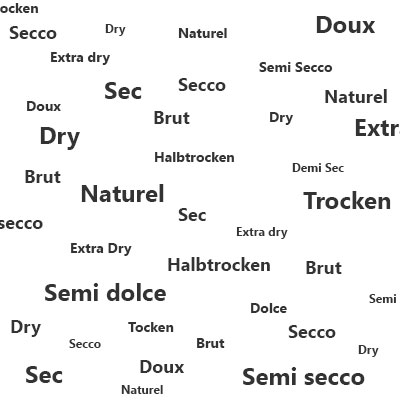Hi,
for second part of sparkling wine posts let’s talk about acidity of the wine and how the wine is paired with the food based on that. The important things that you will learn in this post are how the wine is labeled according to sweetness and how you can use it. Usually when people talk about wine they mention how wine is dry. Dryness in wine means how much sugar contents are there. Less residual sugar means drier wine. And I, unlike most of the women, like dry wine better then sweet.
Dry, sweet, semi dry, brut
Usually when you go to the supermarket or wine store to buy your bubbly, you see a lot of versions from the same producers with different sweetness markings. I can just stand there for hours and hours and read the small print in order to decide which wine suits me and my party the best. The ones that we most often encounter in the liquor shelves are dry, semi dry or brut sparkling wines. I’m not sure If I have ever encountered a sweet sparkling wine in the supermarket. Sometimes I struggle to find a semi dry wine. Most usual ones we find are dry and brut. The sparkling wine has one more extra label that is naturel. Which means acidity wasn’t balanced at the end.
So what do the labels mean:
Naturel – no extra liquid and sugar is added at the end of the second fermentation, so this is the most acidic and dry version of sparkling wine. I still haven’t found one.
Brut, extra dry – acidity in this one is barely corrected. You cannot taste any sugar when you drink it. I like to drink it as a special treat, but that is my personal preference.
Sec , secco, trocken, dry – acidity is corrected to the point where you can’t taste the acid but also can’t taste the sugar.
Demi sec, semi secco, halbtrocken, semi dry – you can now taste sugar. It can be used as an appetizer, and can accompany the desserts.
Dolce, Doux, Sweet – the wine is sweet and is best used as a dessert or accompanying desserts, but depends on the sweetness of desserts.
Pairing the sparkling wine with food
Now, the sweetness or dryness of wine I will choose depends on the use. If I’m going to put some fruit in it (like this year when I used carambola on the top of the glass) I will take semi dry wine. Because fruit has a bit of acid to it, the small sweetness of the semi dry is sure to balance well with the fruit. If I want to use it with appetizers that are salty, I will use a dry wine. The acid in it, just goes much better with the salty taste. It compliments the salty taste and the salty taste accentuates it’s dryness and flavour.
Desserts and dessert sparkling wine
If you want to use the sparkling wine to go with the dessert I would suggest the semi dry or even sweet. Depends on the sweetness of the dessert. ‘Cause sometimes if you blend the sweet wine with too sweet dessert it will be overbearing sweetness. I would actually recommend not to serve the sweet wine WITH the dessert, but server it AFTER a dessert, or even INSTEAD of dessert. That way you can enjoy its sugar and flavour better. But semi dry has enough dryness to accompany most of the desserts well.
Brut wines I usually buy as a special treat. I don’t know why, but if I buy brut wine, I will serve it without food. After some time has passed , and the tongue is cleared of the tastes. Then, it sings on my tongue. I may serve it with some cheese though.
Pairing the wine with food with consideration on dryness
In next table, you can see how I pair wine and food, considering the dryness of the wine. Some may argue with my choices, but this is how I do it:
| Naturel | cheese, alone |
|---|---|
| Brut | cheese, salty appetizers, alone |
| Dry | cheese, salty appetizers, main course, fish course |
| Semi dry | cheese, desserts, fruit, alone |
| Sweet | desserts, fruit, alone |
This is written more as when to use wine, because we should also keep in mind the colour and taste of the wine. More about that in the next chapter.

